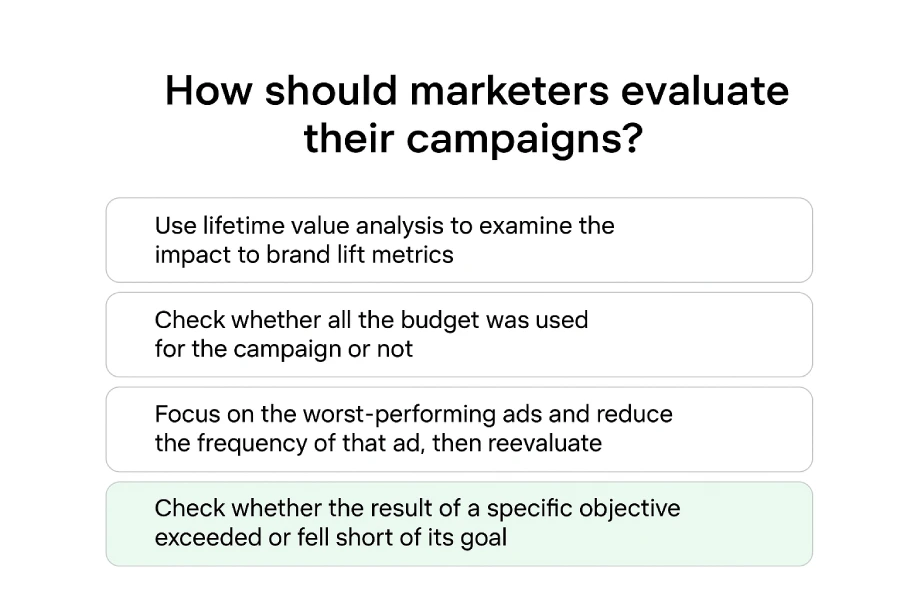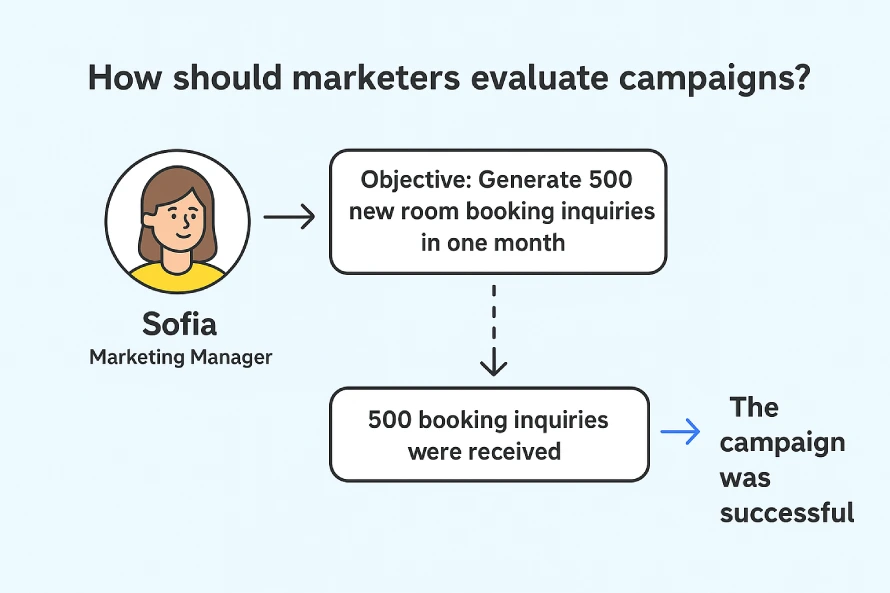The correct answer is “Check whether the result of a specific objective exceeded or fell short of its goal.”
Why is that the right choice, and why are the other options not correct?
In our Miteart blog, I will give you a clear guide on how to choose the correct answer easily. So, no delay—let’s start.

Table of Contents
Question
How should marketers evaluate their campaigns?
- Use lifetime value analysis to examine the impact to brand lift metrics.
- Check whether all the budget was used for the campaign or not.
- Focus on the worst-performing ads and reduce the frequency of that ad, then reevaluate.
- Check whether the result of a specific objective exceeded or fell short of its goal.
The correct answer
✅ Check whether the result of a specific objective exceeded or fell short of its goal.
Details in voice:
Why the correct answer is right
Every campaign is launched with a purpose: generating leads, driving reservations, boosting online sales, or raising awareness. To evaluate effectively, marketers must measure against that objective.
If the objective was website conversions, then metrics like form fills or bookings are the benchmark. If the objective was brand awareness, then impressions, reach, or brand lift are the measure.
This ensures that the evaluation ties directly to strategy, not vanity metrics.
Why the other options are wrong
- Use lifetime value analysis to examine brand lift metrics
Lifetime value (LTV) is important for customer retention and long-term growth. Brand lift tracks awareness and perception. Both are useful, but they don’t replace measuring whether a campaign met its stated objective. - Check whether all the budget was used
Spending the entire budget doesn’t prove success. You can waste money on poor placements. A campaign might use half its budget and still beat its goals. - Focus on the worst-performing ads and reduce frequency
Optimization is useful, but evaluation isn’t about fixing one ad. It’s about seeing if the overall campaign delivered on its main objective.
Real life example

Let’s take Sofia, a marketing manager for a boutique hotel in Rome.
Her team runs a Google Ads campaign with the objective: generate 500 new room booking inquiries in one month.
- At the end of the campaign, Sofia checks whether they reached 500 inquiries. That is the direct way to evaluate the campaign.
- Even if the campaign only spent 80% of the budget, the goal was achieved—so it’s a success.
- Even if one ad performed poorly, the overall campaign hit its target, which is what matters.
- Lifetime value or brand lift might be useful for future analysis, but for this specific campaign evaluation, Sofia compares results directly to the set objective.
This example shows how focusing on the campaign’s objective vs. actual results gives a clear and accurate measure of success.
Comparison table
| Evaluation method | Why it’s flawed / correct |
|---|---|
| Lifetime value vs. brand lift | Useful insights, but not tied to campaign goal |
| Budget spent | Doesn’t prove effectiveness |
| Worst-performing ads | Optimization tactic, not campaign evaluation |
| Objective exceeded or fell short (✔ correct) | Directly tied to campaign success measurement |
Practical tips
- Always define SMART objectives (specific, measurable, achievable, relevant, time-bound).
- Use the right KPIs: conversions for performance, reach for awareness, engagement for content goals.
- Combine evaluation with optimization, but don’t confuse the two.
- Present results as “goal vs. actual” for clarity in reporting.
Relevant resource links
- Google Ads Help – Measure your campaign performance
- Google Analytics Help – Set and evaluate goals
- Think with Google – The importance of setting clear marketing objectives
Conclusion
Marketers should evaluate campaigns by comparing results to the specific objectives set at the start. This ensures that reporting is accurate, strategy-driven, and actionable.
FAQs
Is budget usage important at all?
Yes, but it’s secondary. Underspending can signal efficiency; overspending without results shows waste.
Can brand lift be an objective?
Yes, if the campaign’s goal was awareness. Then brand lift should be the key measure.
How often should campaigns be evaluated?
Evaluate at major milestones and at the end. Ongoing monitoring aids optimization, while evaluation compares results to the original objective.
